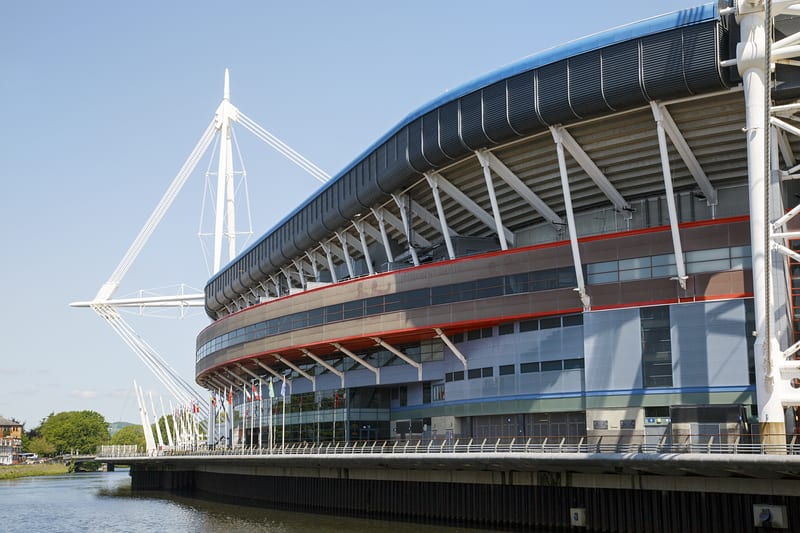Rugby, live in a stadium, is an experience you’ll likely cherish. Watching that match being played out right in front of you, along with thousands of other exuberant fans, is exhilarating and the atmosphere infectious. So where should you sit in a rugby stadium to get the most out of the day?
You should sit in a spot that both meets your budget and will give you your preferred vantage point for watching the match in the stadium. You should also consider what your other requirements will be during the course of the match and where the facilities are that will meet these requirements.

In this article I’m going to run through the different seating areas in the average rugby stadium and the subsequent view you can expect from these spots. I’ll also cover the 9 other things you should consider when thinking about where you should sit.
The Different Stands, Tiers & Blocks In A Rugby Stadium.
In simple terms, there are 2 different types of rugby stadium.
- International Rugby Stadiums
- Club Rugby Stadiums
Both club and international rugby stadiums will normally have 4 stands. 1 down each side of the pitch and 1 at each end. The stands are usually named based on their geographical position, such as:-
- North Stand
- East Stand
- West Stand
- South Stand
If you sit in one of the stands down either side of the pitch:-
- You will get a better view of the movement up and down the field, as each team battles for territory in the match.
- Sat fairly centrally along the pitch side will give you the most balanced perspective of the game. This is the best place to sit in a rugby stadium.
- Sat towards one end will give a closer view of any try line action at that end, but you may find yourself watching the big screens when the action is at the other end of the pitch.
If you sit in a stand at either end of the pitch:-
- You will get a better view of the lateral movement across the field as the players pass the ball wide.
- You will get a better sense of where the space is in the match and be able to see more clearly the running lines and angles of attack that the teams are using.
- You may find yourself using the big screens to watch the game a fair bit, if large periods of the match are being played at the other end of the pitch.
Stadium Sizes & Capacities – What That Means For The Spectators.
On average, international rugby stadiums have a capacity of 70,715 people. In order to accommodate that amount of people, each stand in an international stadium will have a few tiers (something like lower, middle and upper), and each tier will be made up of multiple blocks.
| Rugby Stadium | Team | Capacity |
| FNB Stadium | South Africa | 94,736 |
| ANZ Stadium | Australia | 83,500 |
| Twickenham Stadium | England | 82,000 |
| Stade de France | France | 81,338 |
| Principality Stadium | Wales | 74,500 |
| Stadio Olimpico | Italy | 72,698 |
| Murrayfield Stadium | Scotland | 67,144 |
| Aviva Stadium | Ireland | 51,700 |
| Eden Park | New Zealand | 50,000 |
| Jose Amalfitani Stadium | Argentina | 49,540 |
| Average | 70,715 |

What this means for the spectator:-
- Many spectators will be higher up and more set back from the match than they would in a club stadium. Although further away from the action, sitting here can give you a great perspective on the game as the added height gives you a ‘bird’s eye’ view.
- To help with the fans’ experience, there are more screens in an international stadium, and they are larger.
- The added atmosphere of the sheer volume of people watching the game makes up for the added distance between you and the match being played.
And the club stadiums of the teams in the Gallagher Premiership in the UK have an average capacity of 18,437 people. Because they accommodate fewer people, 3 of the stands tend to be made up of just 1 tier.
| Rugby Stadium | Team | Capacity |
| Coventry Building Society Arena | Wasps | 32,609 |
| Ashton Gate Stadium | Bristol Bears | 27,000 |
| Mattioli Woods Welford Road Stadium | Leicester Tigers | 25,489 |
| Gtech Community Stadium | London Irish | 17,250 |
| Kingsholm Stadium | Gloucester | 16,115 |
| Cinch Stadium at Franklin’s Gardens | Northampton Saints | 15,249 |
| Twickenham Stoop | Harlequins | 14,816 |
| The Recreation Ground | Bath | 14,509 |
| Sandy Park Stadium | Exeter Chiefs | 13,652 |
| AJ Bell Stadium | Sale Sharks | 12,000 |
| Sixways Stadium | Worcester Warriors | 11,499 |
| Copthall / StoneX Stadium | Saracens | 10,500 |
| Kingston Park Stadium | Newcastle Falcons | 10,200 |
| Average | 18,437 |
It’s worth noting though, that often in one of the stands, there will be a tier of terraces (so standing only) in many club stadiums, beneath an upper tier of seating.

What this means for the spectator:-
- Wherever you sit in a club stadium, you’re going to be pretty close to the action.
- This doesn’t mean the views are always great. Often, in the stands at the ends of the pitch in club stadiums, you can’t sit high enough to get that ‘bird’s eye’ view for a decent perspective on the game as a whole.
- Because the Stadiums are smaller, there are fewer screens which aren’t as big as the screens in international stadiums.
What Elements Of The Match Are Important To You?
When you’re wondering where you should sit in a rugby stadium, it’s worth pondering on what parts of the match experience are important to you.
- Do you want to be as close to the action as possible with a good balanced view of the game?
If so, it’s worth aiming for a seat in one of the stands that run along the side of the pitch. And trying to sit somewhere on the midfield.
- Are you a details spectator – do you like watching the replays and TMO decisions being played out?
In which case pay attention to where the screens are in the stadium and try to sit in a spot with a good view of one of them.
- Do you feed off the atmosphere of the game and the joy of the day out with your mates?
Then just make sure you’ve got a block of seats all together. I find that a set of say 5 in front and behind each other works better than a single row of 10.
9 Other Things To Consider.
Take a look at this list below and if anything on it relates to something you’d need, want, might use on the day, or could do without, then factor it in when you’re choosing where to sit.
- Are you planning to visit a bar to get drinks during the match?
- Do you want to drink alcohol while you’re watching the match? Some stadiums have non-drinking zones.
- How quickly do you want to get away once the match has finished?
- Are you planning to visit a food hall to get food during the match?
- Is the stadium covered, or partially covered? And are you ok with being open to the elements? This might influence how you dress. I wrote this article on what to wear to watch a rugby match, which will tell you all you need to know about what clothes to take with you on the day.
- Do you want a good view of the players coming out of the tunnel? And the players’ boxes?
- Are you happy to climb plenty of steps to get to your seat?
- How’s your bladder, and how well do you know yourself! Will you be needing to use a toilet during the match?
- Do you prefer sitting towards the end of a row or more towards the middle?
My Final Tip On Where You Should Sit!
Get a stadium map & pay attention to the stadium layout.
Get hold of a stadium map and have a look at where all the amenities are, especially the ones that you think you’ll use. Bear in mind the other things to consider above and choose some seats that are near to or will help you with some of the considerations that might be a priority for you.
Lastly – You May Have To Compromise.
Don’t fret too much and get unnecessarily stressed trying to find the perfect position in the stadium. The one that ticks all your boxes of preferred vantage point, atmosphere, and amenities nearby. The chances are that you will have to compromise on a few, or even all of the these on the day.
But remember this. Wherever it is that you end up sitting to watch the match, you’re bound to have a fantastic day out and come away buzzing, with new sporting memories to be cherished for years to come.
